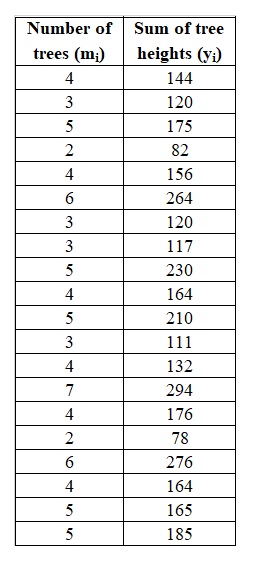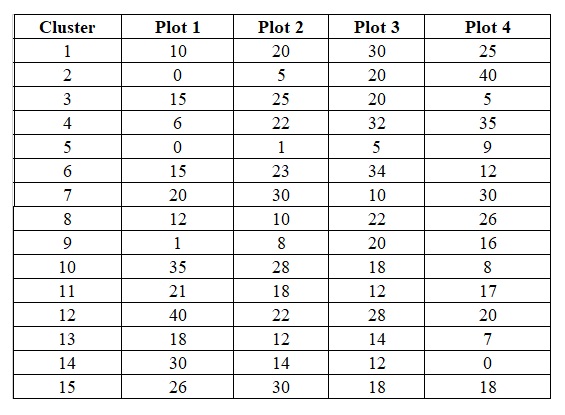F 321 – Assignment #8
BigBAF and Cluster Sampling
Objective: This assignment will ask you to use and explain the concepts of double sampling for implementing BigBAF sampling. Additionally, you will explore the concepts of cluster sampling of forest resources.
Student Learning Outcomes: Upon completing this assignment you should be able to:
- Apply allometric relationships with double sampling to summarize a BigBAF forest inventory.
- Describe the benefits and appropriate uses of cluster sampling.
- Apply one- and two-stage cluster sampling calculations to summarize an inventory.
- Show a mastery of sample design concepts.
- Demonstrate your ability to communicate sampling concepts.
1. When do we use cluster sampling what are its potential benefits?
2. How is cluster sampling different from stratified sampling (what are we looking for in the group relationship)?
3. If you perform a cluster sample with 4 plots in each cluster and 25 total clusters, what would be your ‘n’ value for the statistics?
4. How can you increase the variability within a cluster?
5. When using regression estimation, what conditions need to be met?
6. Give three scenarios that we could use double sampling to improve our estimation of population parameters.
7. Write and define the individual terms of the finite population term. Describe why we use it.
8. What are the three requirements of a sample?
9. You are taking over management of a plantation and have been asked to estimate the average height of trees in the plantation. The plantation has been divided into 400 row-segments, each containing an equal number of original planting spaces (but not an equal number of surviving trees due to differential mortality rates). A simple random sample of 20 row-segments is selected from the 400 segments that compose the plantation. All trees in the sampling segment are measured; estimate the number of trees and average height of trees in the plantation and their standard errors.

10. Your organization established a grid of permanent plots throughout its 60,000 acre forest empire. At the time of establishment management decided to have a cluster represent a 40 acre area. The clusters were laid out using 4 – 0.25 acre plots, with plots established 2 chains from the center of the 40 acre block in each of the cardinal direction. The objective of establishing these clusters was the assessment of periodic growth to be used in forest wide planning. The 10 year periodic cu ft growth per plot in each cluster is provided in the accompanying table. Estimate the forest wide annual growth and its standard error per acre.

11. You have a 60 acre stand of timber that you placed 25 1/10 acre plots on with the following characteristics:
Average volumes: 420 cu ft of PIPO/acre; 380 cu ft of PSME/acre; 210 cu ft of THPL/acre
Standard deviations: 30 cu ft of PIPO/acre; 25 cu ft of PSME/acre; 40 cu ft of THPL/acre
Species value: $280 mbf for PIPO; $320 mbf for PSME; $410 mbf for THPL
You know that the mill you are sending the timber to has a 0.85 recovery rate for converting cu ft to board feet. With 90% certainty what is the maximum amount you could sell the stand for?
12. Using the attached dataset of a stand level cruise performed using the BigBAF sampling approach, were a 20 BAF was used for count trees and a 70 BAF was used to identify measure trees, calculate stand level volume per acre. This will require you to calculate the VBAR estimate from the measured trees and then apply it to all of the plots. Use the Gholz et al. (1979) equations for Total Stem biomass (ST) or stem wood (SW) found in Ter-Mikaelian and Korzukhin (1997) to obtain stem volume allometric relationships. Assume the stand is 64 acres and use the following densities for calculating cu ft volume; DF = 27.84 lb/cu ft; PP = 26.76 lb/cu ft; LP = 27.22 lb/cu ft.


13. For the following scenario, describe the sampling design being implemented using the terminology we have discussed. You should consider how the samples were located, how they were grouped, and the area they represent. You will be evaluated both on proper use of terms and on your writing.
Your organization established a set of permanent sampling points throughout its 600 acre forest empire. The objective of establishing this monitoring protocol was the assessment of periodic growth to be used in forest wide planning. The established design divided the population into 4 acre blocks, from which 15 blocks were selected in a grided fashion across the population. In each selected sampling block four 0.10 acre plots were established at the four corners of the sampling block.
Extra Credit (5 points):
For question #12 calculate the standard error for volume per acre and then calculate a 95% confidence interval for stand level volume, be careful with how you combine your error terms.
